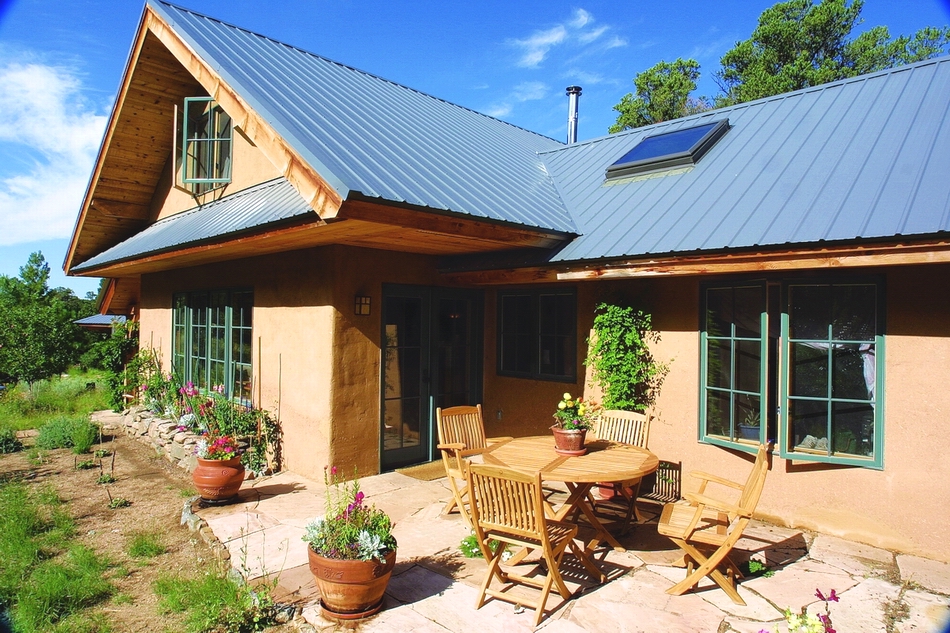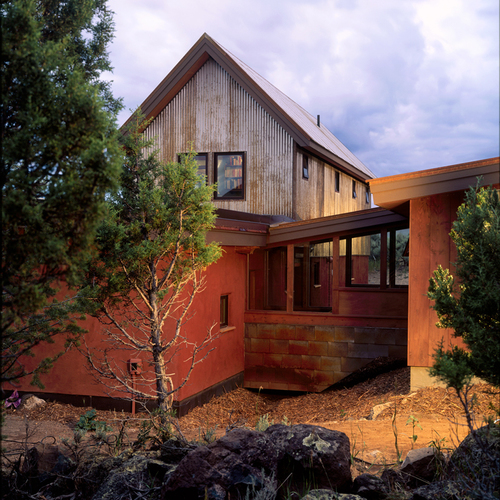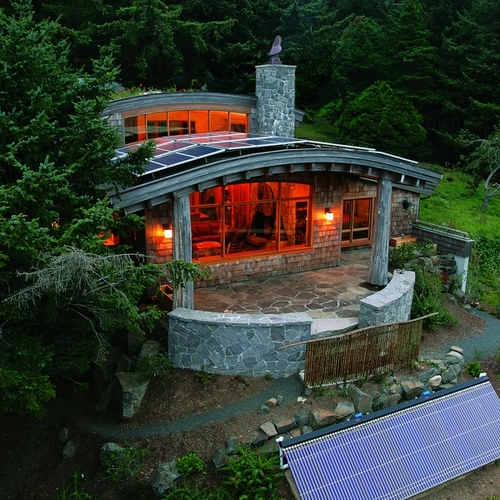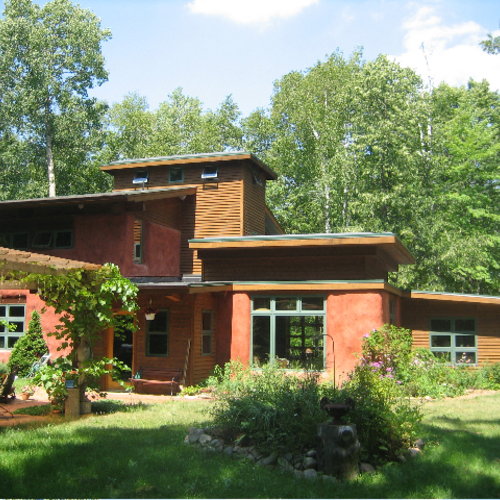
Image Credit: Kevin Ireton/Fine Homebuilding
Image Credit: Kevin Ireton/Fine Homebuilding Adaptable details. The exposed timber frame, shoji screens that disappear into the walls, and different ceiling and floor heights create a variety of nooks within a larger space, keeping the footprint small. Operable skylights also have operable in-ceiling shoji which can be opened for sun or closed for diffused light.
Image Credit: Laurie E. Dickson/EcoNest Making the most of it. This deep built-in is a couch, an extra bed, and storage space—it’s all about getting a small footprint to feel larger by giving things more than one use.
Image Credit: Kevin Ireton/Fine Homebuilding Part of the environment. The main house nestles into the hillside on one level making it accesible and inconspicuous. The clay plaster exterior blends seamlessly with its surroundings because it is made from local materials. A metal roof collects rainwater into underground cisterns.
Image Credit: Kevin Ireton/Fine Homebuilding Natural composite. Building the walls is fairly labor-intensive; the work requires many hands to move large quantities of heavy earth. A custom-made tumbler mixes the clay and straw wall material.
Image Credit: Laurie E. Dickson/Fine Homebuilding #147 Building up. Workers pack the earthen mixture into plywood forms fastened to the timber frame.
Image Credit: Laurie E. Dickson/Fine Homebuilding #147 Closing up the walls. Once the frame is filled with straw and clay, plastering can begin.
Image Credit: Laurie E. Dickson/Fine Homebuilding #147 Healthy and energy efficient. 41 MMBtu/year. A combination of renewable energy, time tested natural building systems, and a site oriented plan pay off with energy consumption of about half the national average. Structure and skin are separate. The walls of this home are mostly a mass of straw and clay, but these materials don't support the weight of the roof. An inner timber frame of locally milled fir provides the building's structure.
Image Credit: Toshi Woudenberg
An architect and carpenter use Bau-Biologie principles to build a healthy and energy efficient home in the New Mexico desert
Bau-Biologie—a construction philosophy focused on using natural materials to build healthy homes—originated in Germany, but in the USA, one epicenter is just outside of Santa Fe. Here, architect Paula Baker-Laporte and Robert Laporte, a master builder, have designed and built many such homes through a partnership they call EcoNest. Their work has helped generate new building codes and standards. Many people—from novice homebuilders to experienced professionals—come from all over the world to apprentice with them and work together, learning and building EcoNest’s signature timber-framed, earthen-walled homes.
A different shade of green
One approach to green building seals a building tightly so that no air gets in or out; problems of condensation, moisture, toxicity, and air changes are managed through ducting and mechanical ventilation. Heating and conditioning mechanisms provide warmth, cooling, and dehumidification.
Building with Bau-Biologie principles, however, uses the walls themselves for the (extremely slow) transpiration of both air and water vapor. Condensation doesn’t occur, so neither does mold. This hygric buffering—a material’s ability to absorb and release moisture naturally and safely—precludes the need for the typical siding and air barriers that are used in conventional frame construction.
The combination of insulation and thermal mass found in the clay and straw walls of these homes makes them ideal for the warm days and cool nights of the southwestern United States, although thoughtful crafting and diligent protection from the elements can make them suitable for many temperate regions.
Using—and improving—what’s at hand
Paula and Robert built the first of these homes for themselves in a narrow, ragged piece of land that no one wanted. Seeing possibility, Robert knew the wash he was looking at provided natural protection from winds and excellent passive solar siting. Over two years, they adapted the land, spending 20% of their construction budget to move mature trees, form bioswales, and build and install gabions (miniature dams), thereby managing the watershed. In so doing, they changed the ecology of the site.
They built a house all on one level to nestle into the land. It has an easy, open center where dining verges on other living areas, and the kitchen flows into a light-filled breakfast nook. Bedrooms, baths, a meditation room, and an office fan out around the edges, and generous porches with deep 4-foot roof overhangs are used frequently as outdoor living space.
At the center is a Tulikivi radiant soapstone fireplace, surrounded by adobe walls, that supplies about half of the home’s heat, with most of the balance coming from a ‘sun bump’—the south-facing breakfast nook that extends to within 18 inches of the roof overhang and has a flagstone floor that holds heat. The last 10% comes from a solar hot water system that also provides domestic hot water, which is ground-mounted and incorporates a heat exchanger. All electrical power is generated by New Mexico turbines, via Windstar, a state utility.
Time-honored materials
Hefty timber framing bears the house’s structural loads. Constructed of local white fir, it is elegantly joined with simple mortising and pegs to allow for flexibility. A Larsen truss, which is basically a hollow, nonload-bearing, light stud framework, wraps the exterior of the timber posts. This provides an envelope for an infill of mixed clay and straw, which is stabilized by horizontal bamboo rods. This foot-thick clay/straw wall has the storage capacity to keep interior temperatures and humidity well-regulated. EcoNest takes pride in using the airborne clay dust reclaimed from a local brick factory for the mixture. Unlike a straw-bale house, the clay/straw combines the insulating properties of straw with the thermal properties of earth. It’s fireproof, doesn’t need added netting to provide grip for finishes, and resists both decay and insects. It may also be more acceptable to local building departments.
A technique wedded to community
Community and skill transferral are EcoNest fundamentals, as important as recycling or R-values. For this house, as for all other EcoNest houses, the clay/straw walls were built by apprentices who intend to use the technology in their own homes and communities.
The apprentices coated both sides of the clay/straw wall with several layers of earth-based plasters. The outside came out a rosy tan, from the tint of the local earth. Inside, reds and yellows emerged from iron oxides, and greenish tones from copper carbonate. No gypsum board, joint fillers, or paint was required. None was desired, either, nor any ducting or air handlers, all of which would have interfered with the transpiration of the walls and window ventilation. “One of the pillars of sustainability is reduced manufacturing,” says Robert.
Weekly Newsletter
Get building science and energy efficiency advice, plus special offers, in your inbox.
Lessons Learned
There are some practical things that EcoNest has learned over time: You need to have an extended dry season to build; you can vary the density of the walls around the house to suit orientation and exposure. Sustainability, though, is a bigger umbrella.
Healthy homes, healthy communities
Bau-Biologie thinks of a building as a “third skin” (your own, and your clothing are the first and second, respectively). Robert says Bau-Biologie studies all of life: ”The building itself is the tip of the iceberg.”
“Bau-Biologie is interdisciplinary,” says Paula. They aren’t just talking about addressing chemical hazards, electromagnetic fields, and the effects of geopathic stresses, although the last two may cut a wider swath than most green-building practices. They are also passionate about whether the building supports the prosperity and health of the owner, the builder, and the community in which that builder and the homeowner live.
Robert lays it out this way: “First, know what you’re building. Understand the science behind the method. Principles allow you to assess the appropriateness of any building method whatsoever. Second, master the technique. Third, when you do it, enroll your community. Best advertising you can do.” He adds, “Ask yourself each day before you start, Why am I doing this? Pretty soon, you’ll get yourself on track, if your body isn’t telling you already.”
General Specs and Team
| Location: | Santa Fe, NM |
|---|---|
| Bedrooms: | 2 |
| Bathrooms: | 2 |
| Living Space: | 1470 |
| Additional Notes: | Completed: 1999 |
Builder: Robert Laporte EcoNest
Architect/designer: Paula Baker-Laporte EcoNest
Landscape architect: Green by Design, Design with Nature
Engineer: Bill Druc P.E., Druc Engineering LLC
Construction
Foundation: alternates between stone-tiled 4-in. concrete slab, troweled earthen floors, and flagstone, all over 6-in. pumice base; concrete footing, composite wood/cemen/mineral wool ICF stem wall (R-20, Durisol)
Walls: traditional timber frame; 12-in. Larsen truss rests on ICFs and bolts to timber frame, contains clay/straw infill on exterior (double 2x3 studs at 24 in. o.c., 1/2-in. ply gussets; R-13); straw has bamboo "rebar" at 24-in. o.c. faced with hand-troweled clay-based plaster.
Roof: 2x12 rafters; plywood sheathing; metal roof; formaldehyde-free fiberglass insulation, R-foil (R-38); continuous 4-ft. soffit/eave, vented; 2-in. rigid insulation for thermal break
Windows: metal-clad, double-pane, low-E2, argon-filled (U-factor < 0.32, SHGC = 0.41; Pozzi)
Energy
- Passive solar orientation, solarium, natural daylighting and ventilation, integrated shade
- High-thermal-mass adobe walls; clay/straw walls add thermal mass and provide insulation
- High-performance insulation; careful envelope sealing
- Energy Star lights, fixtures, and kitchen appliances
- Soapstone fireplace (Tulikivi)
- Whole-house fan
- Public utility wind-generated power
Energy Specs
Heating: Passive solar; radiant floor heat fed by solar hot water collectors and gas fired boiler (95% AFUE, Buderus GB142); Wood fired masonry heater (Tulikivi)
Water heating: 5 flat-plate collectors, 175 Gallon storage tank; oil boiler for backup hot water
Annual energy use: 41 MMBtu (electric=3,820KwH, gas=280 Therms)
Water Efficiency
- Conscious consumption by homeowner
- Low-flow fixtures
- Reuse of gray water from kitchen, laundry, and bath tub
- Rainwater collection in underground tanks (4,500 gal. total)
Indoor Air Quality
- Vapor-permeable walls
- Operable windows, cross ventilation
- Interior wall finishes are latex-free, vapor-permeable, and contain no VOCs
- Sealants, laminates, and adhesives contain no VOCs
- All-natural building materials predominate
- Wool area rugs
Green Materials and Resource Efficiency
- Minimal site disturbance during construction
- Gabions and planting of 28 mature trees for stormwater management
- Timber frame of sustainably harvested native white fir
- Natural, biodegradable construction methods; minimal waste
- Low-maintenance clay plaster interior and exterior
- Eco-landscaping—limited lawn; native, drought-resistant plants
- Nontoxic materials and methods employed
- Flooring materials of local stone, earth, travertine, and bamboo
- Permeable paving










One Comment
Home Remodeling
I applaud Econest for their valiant efforts in new (or, in reality, quite old) building material use. Ever since the earthships of the 1970s the evidence has been there that rammed earth structures were extremely eco-conscious, though I can't say as I've seen much evidence outside the southwest of that message reaching builders and home buyers. I wish econest the utmost success with their new venture.
Log in or create an account to post a comment.
Sign up Log in